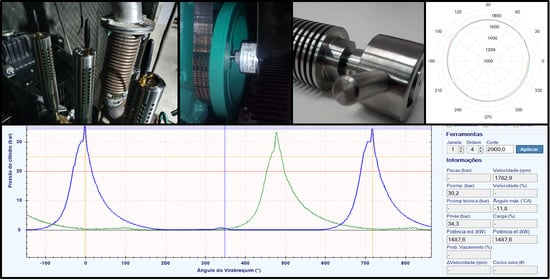Reduced Scale Laboratory for Training and Research in Condition-Based Maintenance Strategies for Combustion Engine Power Plants and a Novel Method for Monitoring of Inlet and Exhaust Valves
Abstract
:1. Introduction
2. Materials and Methods
2.1. General Description of an ICE and Its Pressure Curve
- The cycle starts with the piston ina motion towards the bottom part of the cylinder and the opening of the inlet valve in order to fill the cylinder with air. Due to the movement of the crankshaft, the pistons operate in alternate motion, and, as soon as it reaches the bottom of the cylinder, it returns towards the top.
- During motion towards the top, the injection valve releases fuel oil in the cylinder aiming the ignition of the mixture of air and fuel inside the cylinder.
- As the piston is in upward motion, the compression of the fuel oil produces the combustion of the fuel. The resulting combustion produces a movement of the piston towards the bottom of the cylinder. Whenever the piston starts to move upwards again, the exhaust gas valve releases the hot gases produced in the fuel combustion.
- The alternating movement of the pistons is transmitted to the crankshaft through the connecting rod. As a synchronous generator is connected to the shaft, electricity is then generated.
- Instant where the maximum combustion pressure occurs.
- Descending of the piston.
- Half-way of descending of the piston.
- Instant where the piston is at the BDC.
- The pressure from the exhaust manifold enters into the cylinder as the pressure from the outside is greater than the pressure from the inside.
- Cylinder pressure rises to equalize with manifold pressure.
- After the BDC, the piston starts to ascend (which promotes the exhaust gases) and the pressure decreases.
- Opening of the intake valve.
- Closing of exhaust valve (intake valve still opened). Cylinder pressure starts to drop until equalize with the manifold pressure at Point 10.
- Cylinder pressure equalizes with manifold pressure.
- Closing of the intake valve and increase in pressure.
- Instant where the piston is at the TDC.
2.2. Reduced Scale Model of ICE-Based Power Generator
2.2.1. Adaptation of Thompson Valves to the Cylinder Head
2.2.2. Adaptation of Incremental Encoder to the Crankshaft
2.3. Reduced Costs Monitoring System
2.3.1. In-Cylinder Pressure Sensor
2.3.2. Angular Velocity and Position
2.3.3. Rocker Arm Sensor
3. Results and Discussion
3.1. 96 kW Variable Load
3.2. Comparison between the Proposed In-Cylinder Sensor against a Commercial Solution
3.3. Reduced Scale Laboratory with Failure at Fuel Injection of Cylinder 06
3.4. Failure Detection Using the Proposed Instantaneous Velocity Sensor
3.4.1. Sensibility to Load Variations
3.4.2. Sensibility to Fuel Injection Failure at a Cylinder
3.4.3. Sensibility to Loose Clearance at the Air Inlet Valve of a Cylinder
3.5. Position of Inlet and Exhaust Valves
3.6. Comparative Summary
4. Conclusions
Author Contributions
Funding
Institutional Review Board Statement
Informed Consent Statement
Acknowledgments
Conflicts of Interest
Abbreviations
| ADC | Analog-to-Digital Converter |
| ANEEL | Agência Nacional de Energia Elétrica (Brazilian Electricity Regulatory Agency) |
| BDC | Bottom Dead Center |
| CBM | Condition-Based Maintenance |
| ESA | Electrical Signature Analysis |
| FRA | Frequency Response Analysis |
| GD | Gas-Diesel (GD) |
| GPIO | General Purpose Input/Output |
| HFO | Heavy Fuel Oil |
| ICE | Internal Combustion Engine |
| TDC | Top Dead Center |
| TPP | Thermal Power Plants |
| TPS | Throttle Position Sensor |
References
- Salomon, C.P.; Ferreira, C.; Sant’Ana, W.C.; Lambert-Torres, G.; Borges da Silva, L.E.; Bonaldi, E.L.; de Oliveira, L.E.d.L.; Torres, B.S. A Study of Fault Diagnosis Based on Electrical Signature Analysis for Synchronous Generators Predictive Maintenance in Bulk Electric Systems. Energies 2019, 12, 1506. [Google Scholar] [CrossRef] [Green Version]
- Ribeiro, L.C.; Bonaldi, E.L.; de Oliveira, L.E.L.; Borges da Silva, L.E.; Salomon, C.P.; Santana, W.C.; Borges da Silva, J.G.; Lambert-Torres, G. Equipment for Predictive Maintenance in Hydrogenerators. AASRI Procedia 2014, 7, 75–80. [Google Scholar] [CrossRef]
- Sant’Ana, W.C.; Lambert-Torres, G.; Borges da Silva, L.E.; Bonaldi, E.L.; de Lacerda de Oliveira, L.E.; Salomon, C.P.; Borges da Silva, J.G. Influence of rotor position on the repeatability of frequency response analysis measurements on rotating machines and a statistical approach for more meaningful diagnostics. Electr. Power Syst. Res. 2016, 133, 71–78. [Google Scholar] [CrossRef]
- Mendonca, P.; Bonaldi, E.; de Oliveira, L.; Lambert-Torres, G.; da Silva, J.B.; da Silva, L.B.; Salomon, C.; Santana, W.; Shinohara, A. Detection and modelling of incipient failures in internal combustion engine driven generators using Electrical Signature Analysis. Electr. Power Syst. Res. 2017, 149, 30–45. [Google Scholar] [CrossRef]
- Maridis GmbH. MarPrime Technical Data; Maridis GmbH: Rostock, Germany, 2015. [Google Scholar]
- Chris-Marine, A.B. LEMAG ECI Product Sheet; Chris-Marine AB: Malmö, Sweden, 2019. [Google Scholar]
- Friedrich Leutert GmbH & Co. KG. Digital Pressure Indicator DPI Data Sheet; Friedrich Leutert GmbH & Co. KG: Adendorf, Germany, 2019. [Google Scholar]
- Cummins Power Generation. Grupos Geradores Diesel-Catalog 5001120; Cummins Power Generation: Columbus, IN, USA, 2016. [Google Scholar]
- Wärtsilä Corporation. Wärtsilä 46 Technology Review; Wärtsilä Corporation: Helsinki, Finland, 2008. [Google Scholar]
- Guedes, C.F.B. An Overview of the Network for Research and Development (R&D) on Public Policy of the Brazilian Electricity Sector; The George Washington University—Minerva Program; Spring: Washington, DC, USA, 2011. [Google Scholar]
- d’Ambrosio, S.; Ferrari, A.; Galleani, L. In-cylinder pressure-based direct techniques and time frequency analysis for combustion diagnostics in IC engines. Energy Convers. Manag. 2015, 99, 299–312. [Google Scholar] [CrossRef]
- Romani, L.; Bianchini, A.; Vichi, G.; Bellissima, A.; Ferrara, G. Experimental Assessment of a Methodology for the Indirect in-Cylinder Pressure Evaluation in Four-Stroke Internal Combustion Engines. Energies 2018, 11, 1982. [Google Scholar] [CrossRef] [Green Version]
- Wang, Q.; Sun, T.; Lyu, Z.; Gao, D. A Virtual In-Cylinder Pressure Sensor Based on EKF and Frequency-Amplitude-Modulation Fourier-Series Method. Sensors 2019, 19, 3122. [Google Scholar] [CrossRef] [PubMed] [Green Version]
- Valencia-Duque, A.F.; Cardenas-Pena, D.A.; Alvarez-Meza, A.M.; Orozco-Gutierrez, A.A.; Quintero-Riaza, H.F. Tdnn-Based Engine In-Cylinder Pressure Estimation from Shaft Velocity Spectral Representation. Sensors 2021, 21, 2186. [Google Scholar] [CrossRef] [PubMed]
- Lewis, R. Wear of Diesel Engine Inlet Valves and Seats. Ph.D. Thesis, University of Sheffield, Sheffield, UK, 2000. [Google Scholar]
- Vardar, N.; Ekerim, A. Investigation of exhaust valve failure in heavy-duty diesel engine. Gazi Univ. J. Sci. 2010, 23, 493–499. [Google Scholar]
- Basbous, T.; Younes, R.; Ilinca, A.; Perron, J. Fuel consumption evaluation of an optimized new hybrid pneumatic–combustion vehicle engine on several driving cycles. Int. J. Engine Res. 2012, 13, 253–273. [Google Scholar] [CrossRef]
- Balmelli, M.; Zsiga, N.; Merotto, L.; Soltic, P. Effect of the Intake Valve Lift and Closing Angle on Part Load Efficiency of a Spark Ignition Engine. Energies 2020, 13, 1682. [Google Scholar] [CrossRef] [Green Version]
- Yin, S. Volumetric Efficiency Modeling of a Four Stroke IC Engine. Master’s Thesis, Colorado State University, Fort Collins, CO, USA, 2017. [Google Scholar]
- Bonaldi, E.L.; de Souza, S.F.; de Souza Lima, D.; da Costa Lacerda, J.; da Silva, L.E.B.; de Oliveira, L.E.d.L.; de Oliveira Assuncao, F.; Santos, C.A.; Teixeira, C.E.; Campos, M.M.; et al. Monitoring System of Power Operation Condition of Internal Combustion Engines. In Proceedings of the 13th Latin-American Congress On Electricity Generation and Transmission—CLAGTEE 2019, Santiago, Chile, 20–23 October 2019. [Google Scholar]
- Behre, L.; Mercorelli, P. Sensing of the Engine Cylinder Valves Motion. Proceedings 2017, 1, 26. [Google Scholar] [CrossRef] [Green Version]
- Boas, F.M.V.; da Silva, L.E.B.; Villa-Nova, H.F.; Bonaldi, E.L.; Oliveira, L.E.L.; Lambert-Torres, G.; de Oliveira Assuncao, F.; de Almeida Costa, C.I.; Campos, M.M.; Sant’Ana, W.C.; et al. Condition Monitoring of Internal Combustion Engines in Thermal Power Plants based on Control Charts and Adapted Nelson Rules. Energies 2021, 14, 4924. [Google Scholar] [CrossRef]
- Tunestal, P. TDC offset estimation from motored cylinder pressure data based on heat release shaping. Oil Gas Sci. Technol.- D’IFP Energies Nouv. 2011, 66, 705–716. [Google Scholar] [CrossRef] [Green Version]
- Kurtz, A.; Kane, A.; Goodman, S.; Landmann, W.; Geras, L.; Ned, A. High Accuracy Piezoresistive Internal Combustion Engine Transducers; Automotive Testing Expo: Messe Stuttgart, Germany, 2004. [Google Scholar]
- Bąkowski, A.; Radziszewski, L.; Žmindák, M. Dynamic pressure measurement and uncertainty analysis using a piezoelectric transducer for a combustion engine. Appl. Mech. Mater. 2016, 827, 77–82. [Google Scholar]
- Wlodarczyk, M.T. Fiber optic-based in-cylinder pressure sensor for advanced engine control and monitoring. Combust. Engines 2012, 151, 3–8. [Google Scholar] [CrossRef]
- KELLER AG. Series 7L Piezoresistive OEM Pressure Transducers with High Stability in a Compact Design—Edition 01/2021; KELLER AG: Winterthur, Switzerland, 2021. [Google Scholar]
- Texas Instruments. CC3200 SimpleLink Wi-Fi and Internet-of-Things Solution, a Single-Chip Wireless MCU-SWAS032F; Texas Instruments: Dallas, TX, USA, 2015. [Google Scholar]
- SICK AG. DFS60-TDPA65536 Product Satasheet; SICK AG: Waldkirch, Germany, 2021. [Google Scholar]
- Santos, A.Q.O.; da Silva, A.R.; Ledesma, J.J.G.; de Almeida, A.B.; Cavallari, M.R.; Junior, O.H.A. Electricity Market in Brazil: A Critical Review on the Ongoing Reform. Energies 2021, 14, 2873. [Google Scholar] [CrossRef]
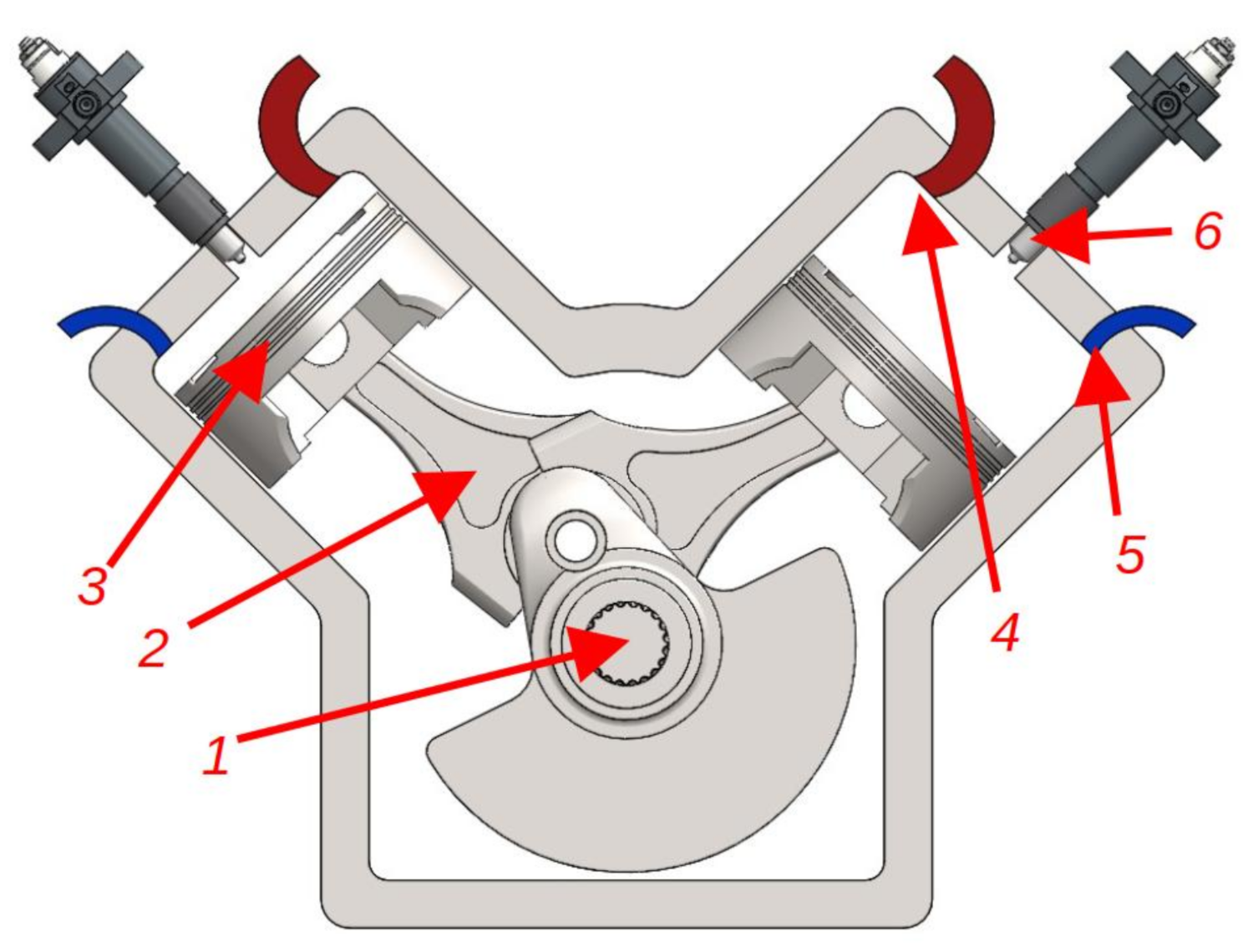


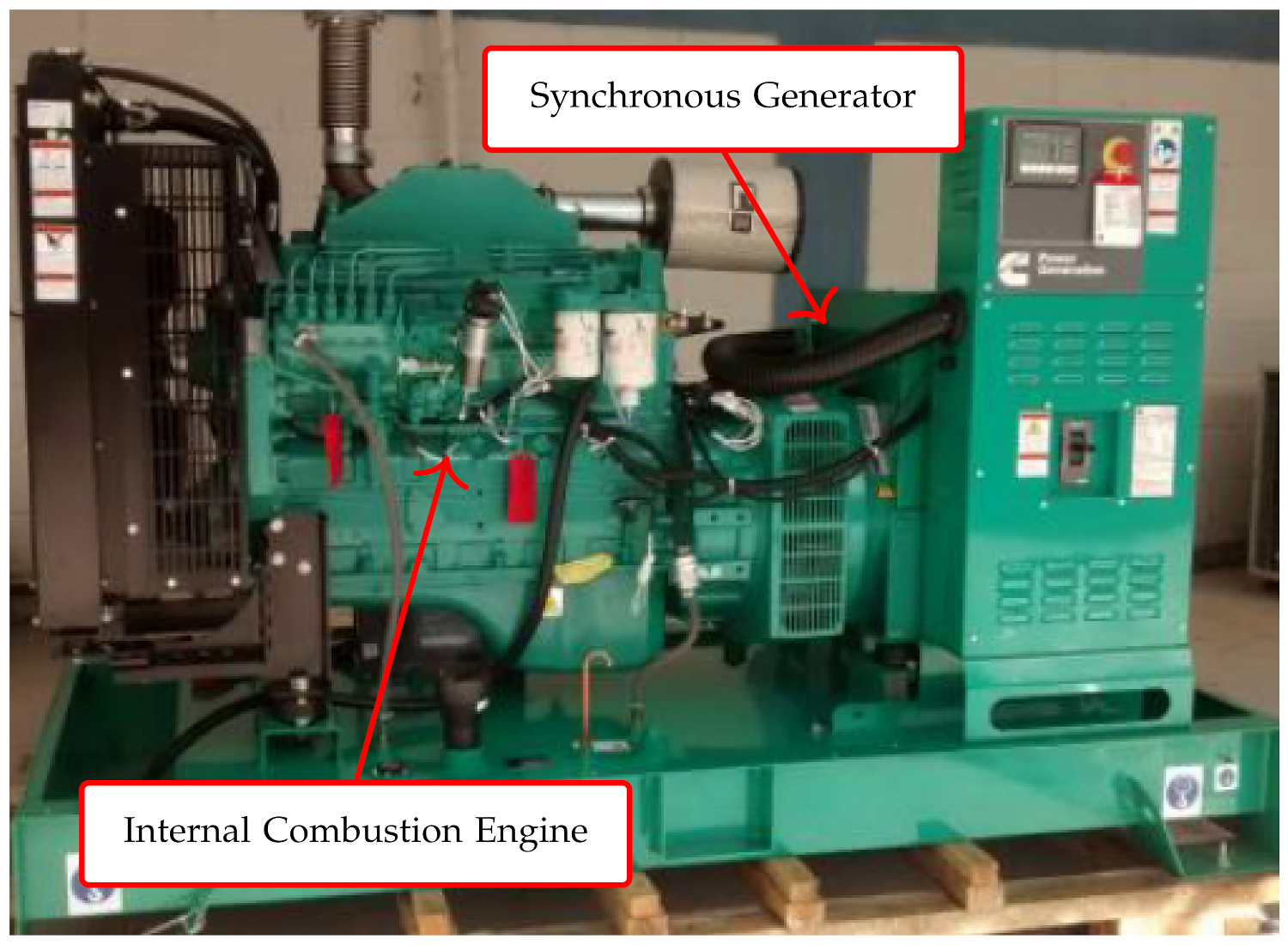


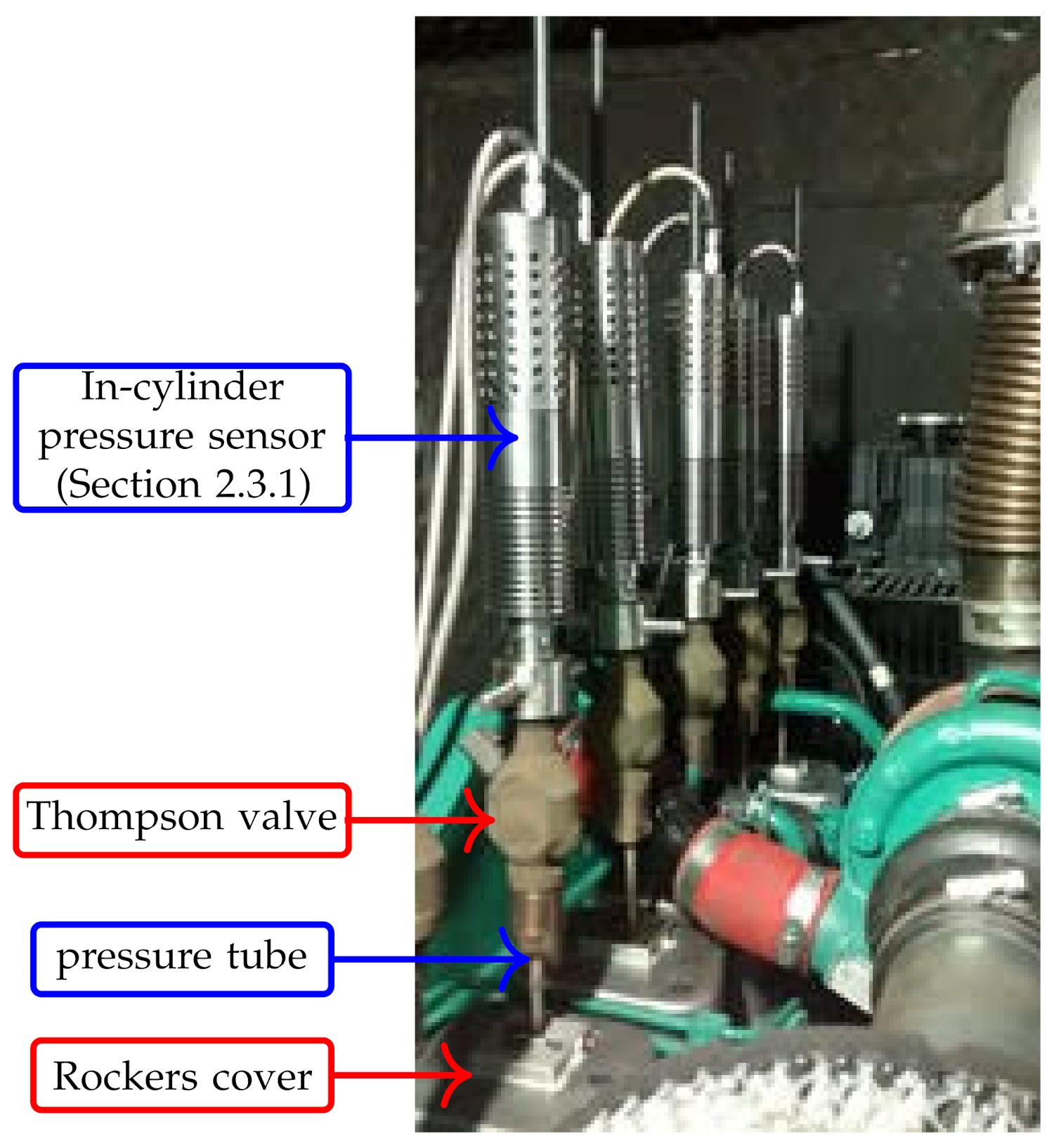



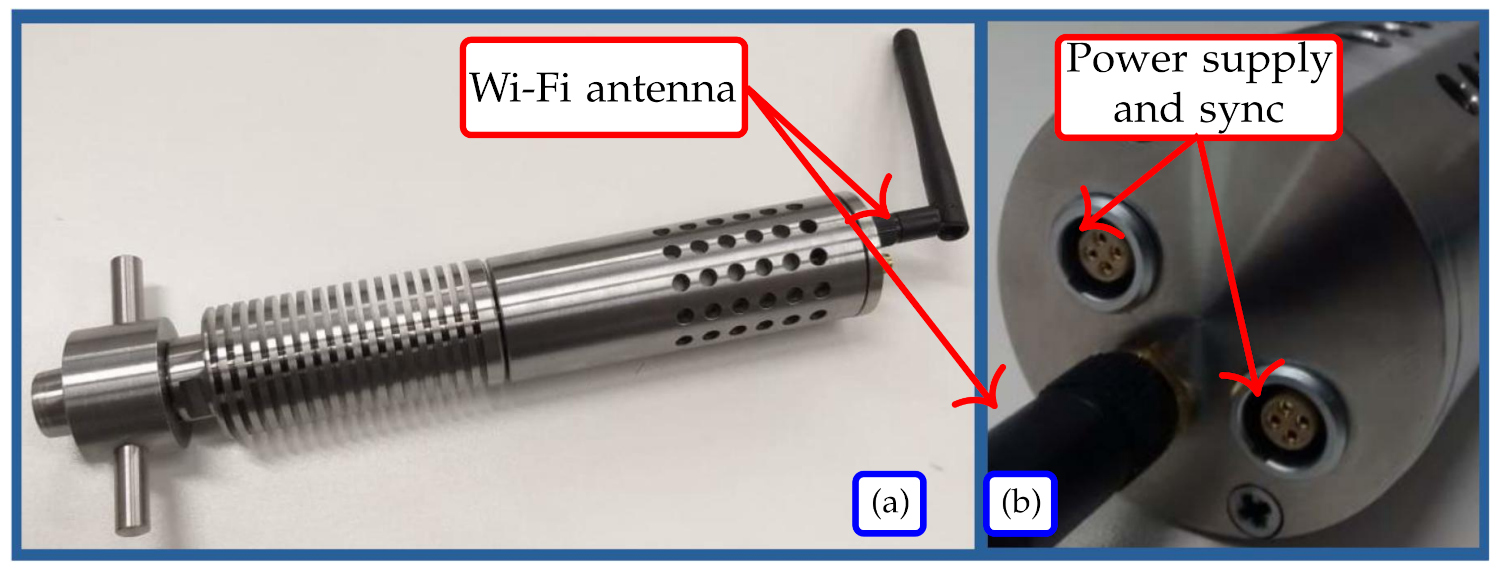

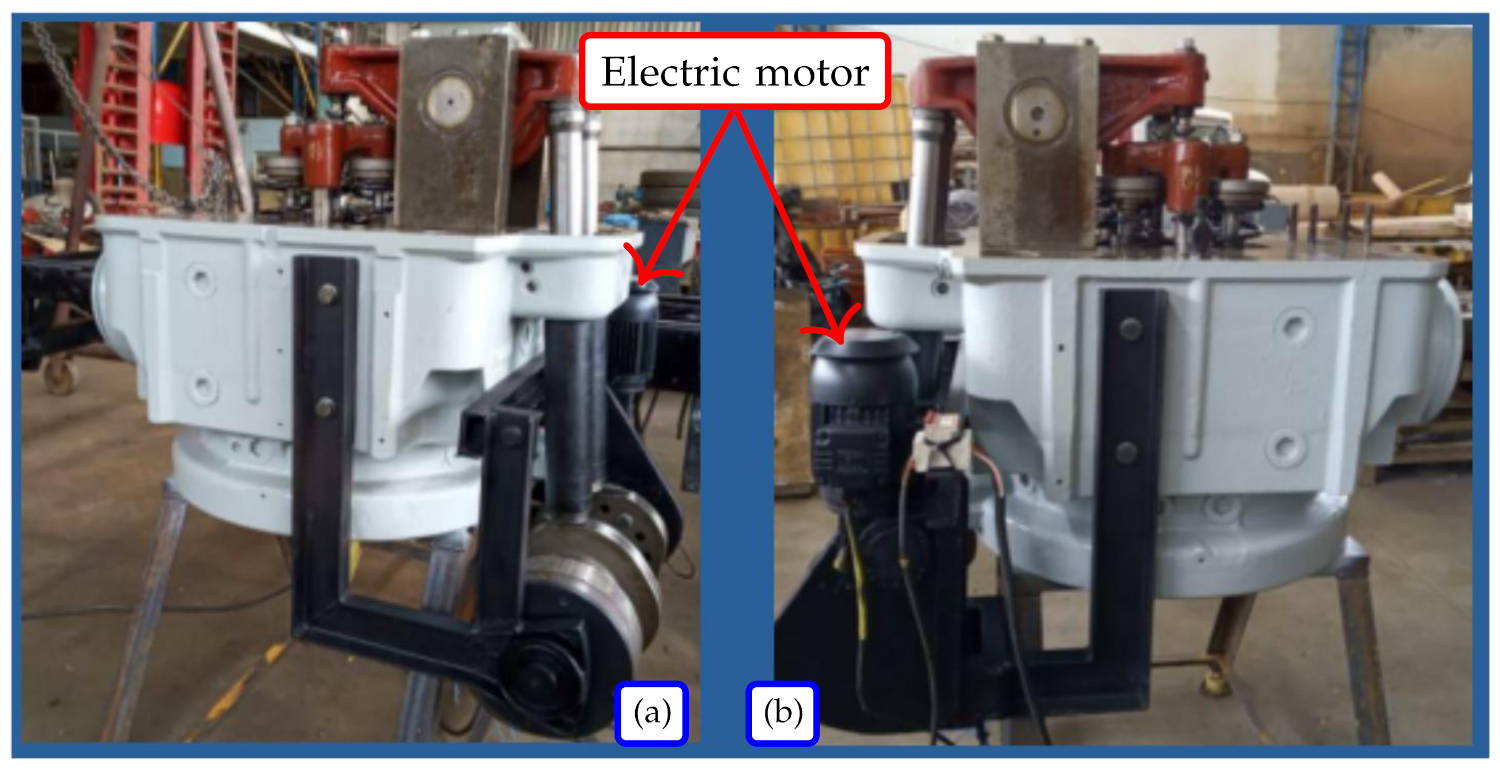








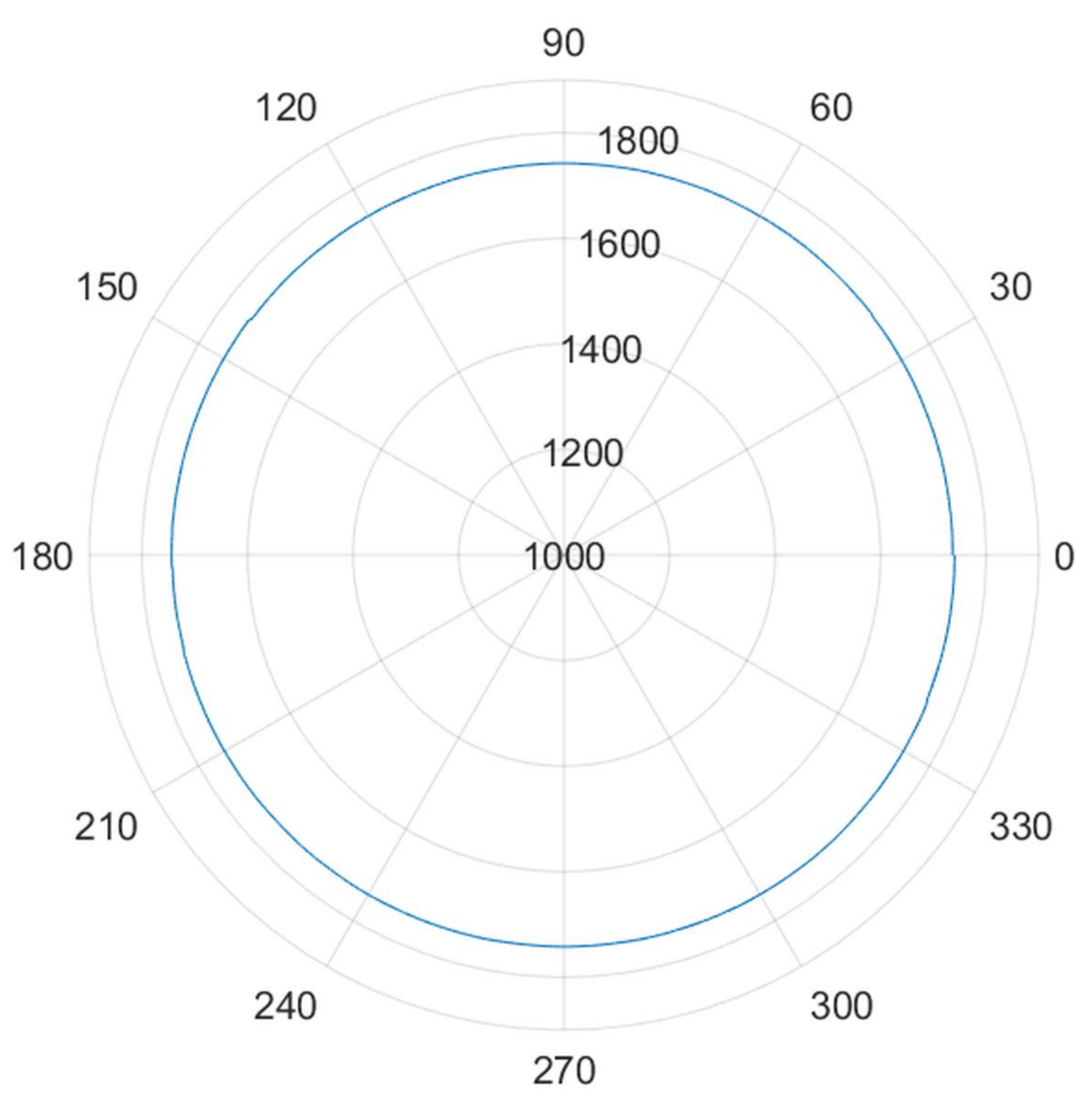

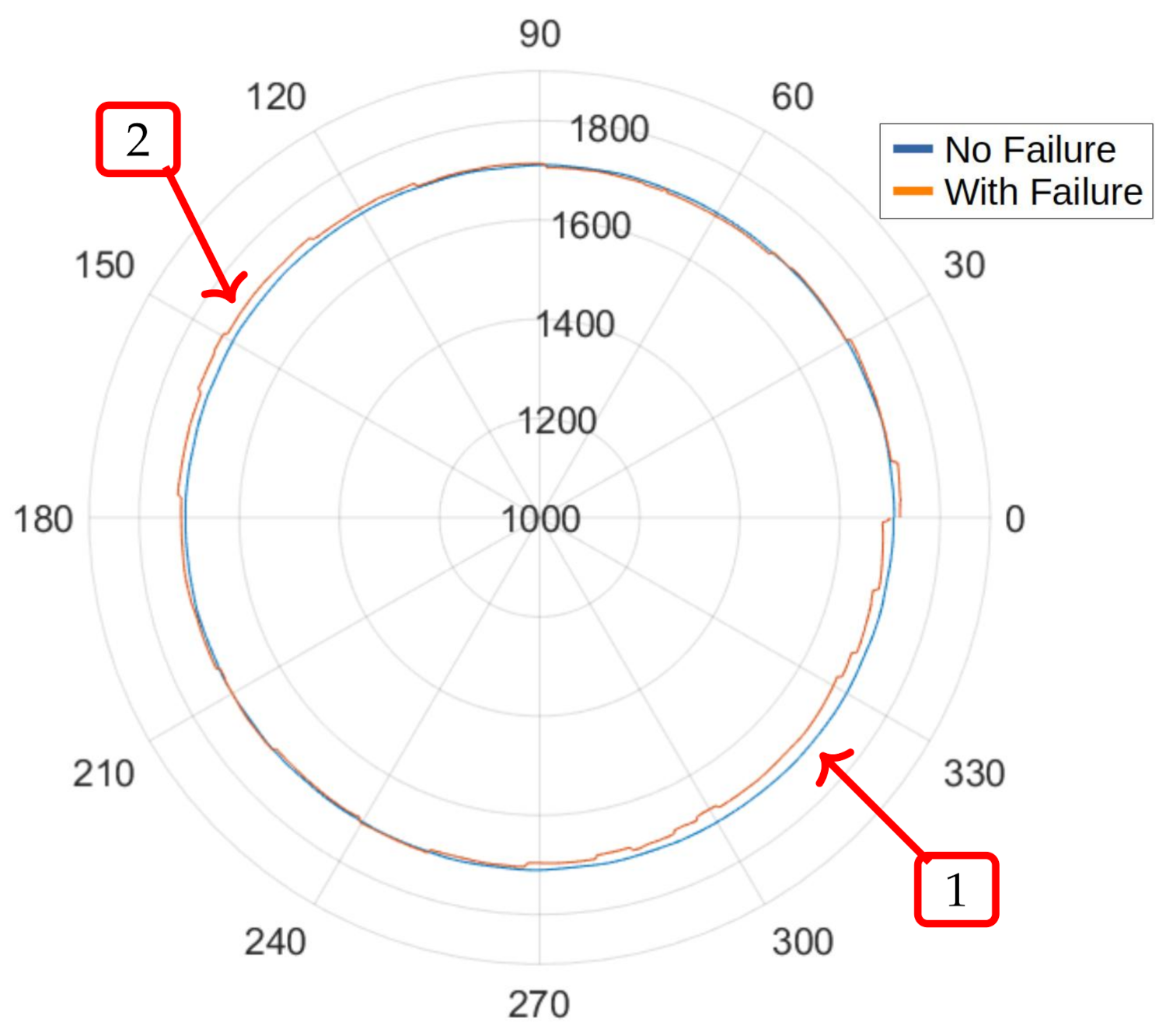





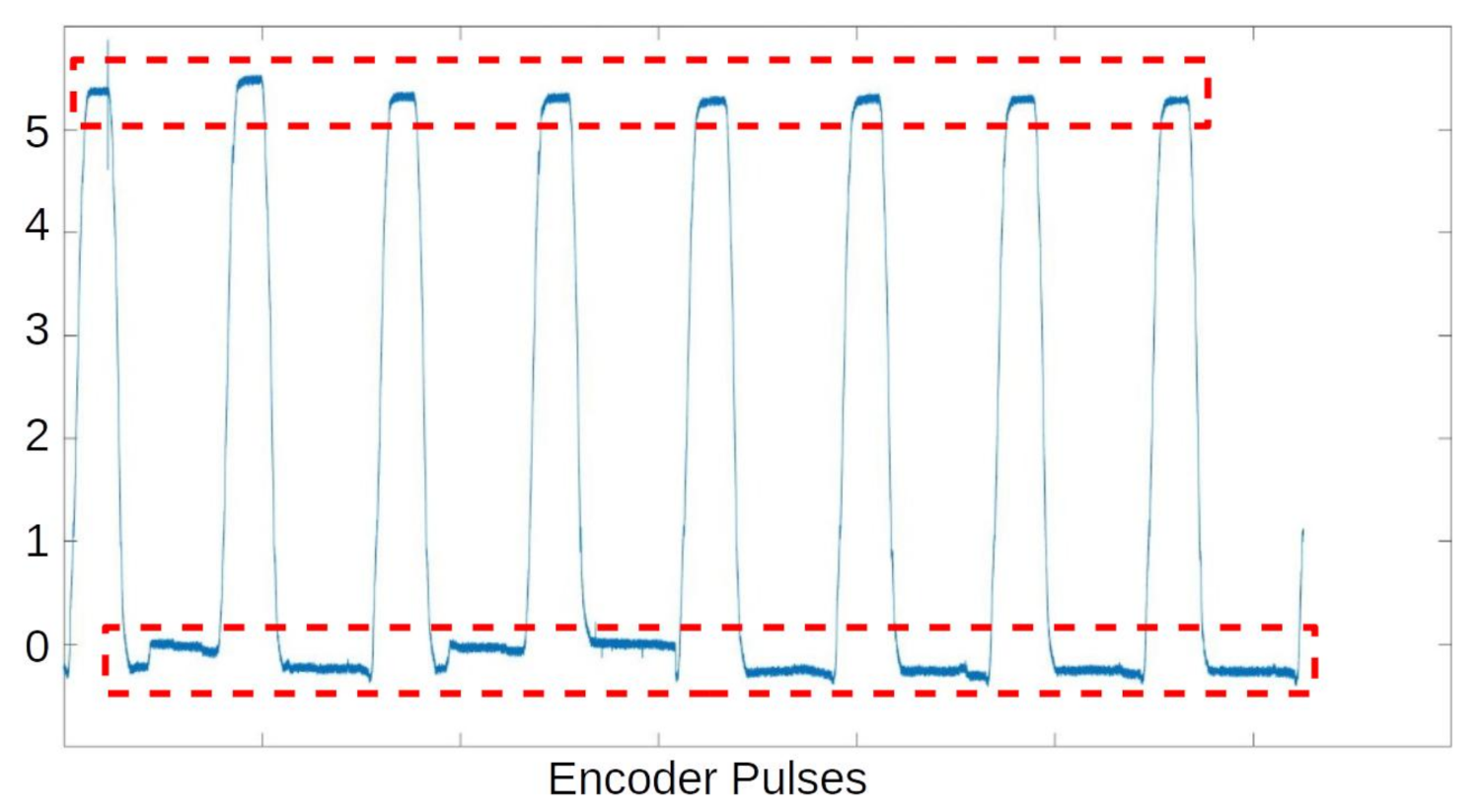

| Feature | MarPrime Ultra | Proposed System |
|---|---|---|
| In-cylinder pressure | ✓ | ✓ |
| Inlet and Exhaust valves | ✓ | ✓ |
| Immunity to noise on the valve measurements | ✗ | ✓ |
| Online acquisition | ✗ | ✓ |
| Synchronism with crank angle | ✗ | ✓ |
| Cycle-to-cycle evaluation | ✗ | ✓ |
| Possibility of repair in the pressure sensor | ✗ | ✓ |
| Brazilian national product | ✗ | ✓ |
| Price at the Brazilian market * | 80,000 BRL (≈ 15,140 USD) | 30,000 BRL (≈ 5690 USD) |
Publisher’s Note: MDPI stays neutral with regard to jurisdictional claims in published maps and institutional affiliations. |
© 2021 by the authors. Licensee MDPI, Basel, Switzerland. This article is an open access article distributed under the terms and conditions of the Creative Commons Attribution (CC BY) license (https://creativecommons.org/licenses/by/4.0/).
Share and Cite
Assuncao, F.d.O.; Borges-da-Silva, L.E.; Villa-Nova, H.F.; Bonaldi, E.L.; Oliveira, L.E.L.; Lambert-Torres, G.; Teixeira, C.E.; Sant’Ana, W.C.; Lacerda, J.; da Silva Junior, J.L.M.; et al. Reduced Scale Laboratory for Training and Research in Condition-Based Maintenance Strategies for Combustion Engine Power Plants and a Novel Method for Monitoring of Inlet and Exhaust Valves. Energies 2021, 14, 6298. https://doi.org/10.3390/en14196298
Assuncao FdO, Borges-da-Silva LE, Villa-Nova HF, Bonaldi EL, Oliveira LEL, Lambert-Torres G, Teixeira CE, Sant’Ana WC, Lacerda J, da Silva Junior JLM, et al. Reduced Scale Laboratory for Training and Research in Condition-Based Maintenance Strategies for Combustion Engine Power Plants and a Novel Method for Monitoring of Inlet and Exhaust Valves. Energies. 2021; 14(19):6298. https://doi.org/10.3390/en14196298
Chicago/Turabian StyleAssuncao, Frederico de Oliveira, Luiz Eduardo Borges-da-Silva, Helcio Francisco Villa-Nova, Erik Leandro Bonaldi, Levy Ely Lacerda Oliveira, Germano Lambert-Torres, Carlos Eduardo Teixeira, Wilson Cesar Sant’Ana, Josue Lacerda, Jose Luiz Marques da Silva Junior, and et al. 2021. "Reduced Scale Laboratory for Training and Research in Condition-Based Maintenance Strategies for Combustion Engine Power Plants and a Novel Method for Monitoring of Inlet and Exhaust Valves" Energies 14, no. 19: 6298. https://doi.org/10.3390/en14196298







